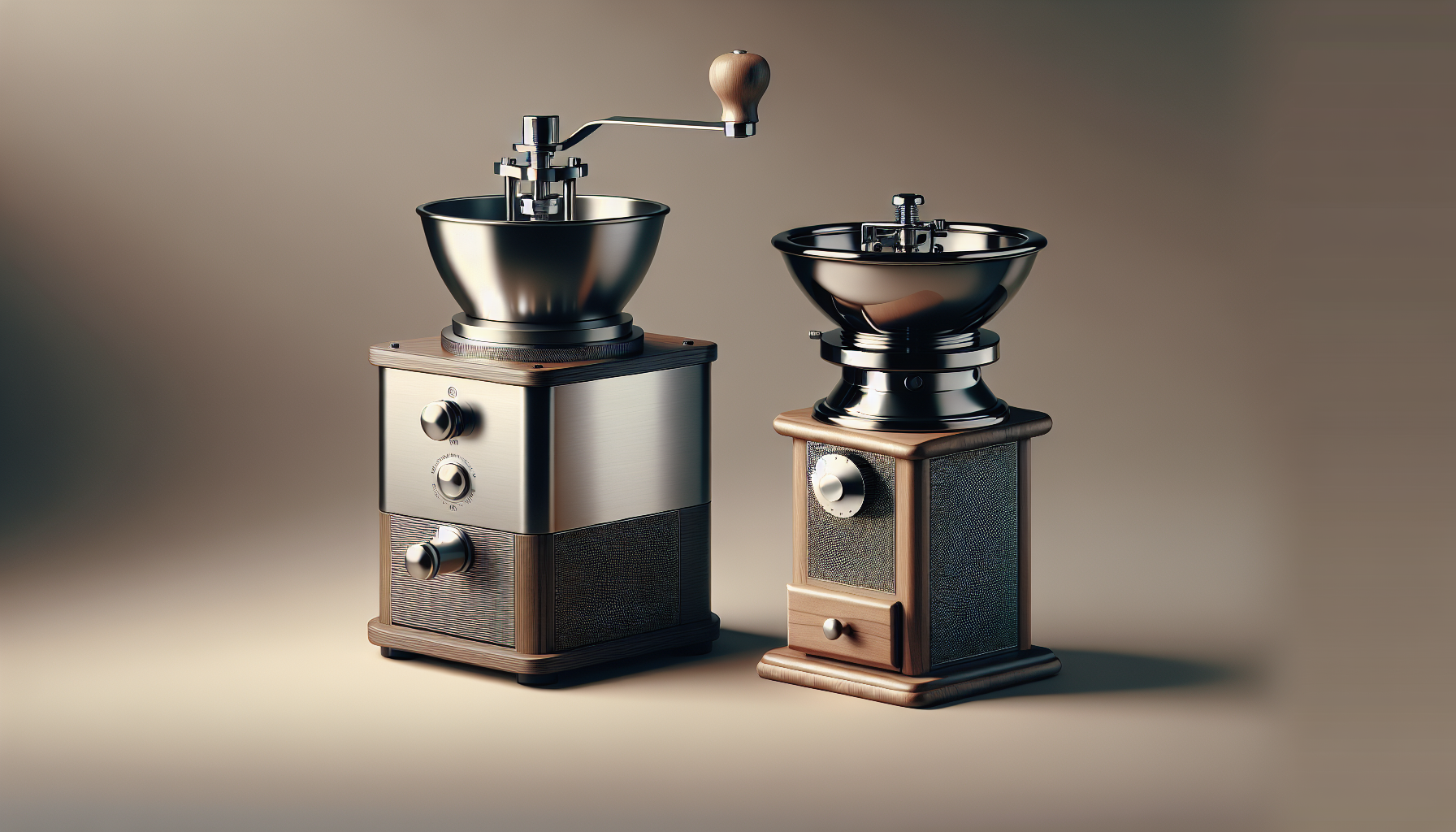If you’re a coffee lover, chances are you’ve heard the debate surrounding burr and blade grinders. But which one is truly superior? In this article, we’ll explore the merits of burr grinders and investigate whether they live up to the hype. So sit back, grab a cup of your favorite brew, and let’s unravel the secrets of these grinding machines. Get ready to upgrade your coffee game!
CHECK OUT COFFEE GRINDERS ON AMAZON
Burr Grinder vs Blade Grinder
When it comes to grinding your coffee beans, the choice between a burr grinder and a blade grinder is an important one. While both options can get the job done, there are key differences in the grinding mechanism, particle consistency, control over grind size, heat generation, and suitability for different brewing methods. Let’s take a closer look at each of these factors to determine whether a burr grinder is really better than a blade grinder.
CHECK OUT COFFEE GRINDERS ON AMAZON
Grinding Mechanism of Burr Grinder
The grinding mechanism is where the main distinction between burr grinders and blade grinders lies. Burr grinders use two abrasive surfaces, called burrs, to crush and grind the coffee beans. These burrs can be conical or flat, each offering its own unique advantages.
Conical Burr Grinder
A conical burr grinder features two cone-shaped burrs, one stationary and the other rotating. As the beans pass between these burrs, they are crushed and ground into consistent particles. The conical shape allows for a slower grind speed, which is beneficial in preserving the flavor and aroma of the coffee beans. Additionally, conical burr grinders tend to produce less heat during the grinding process, resulting in a better-tasting cup of coffee.
Flat Burr Grinder
On the other hand, a flat burr grinder consists of two flat, parallel burrs that crush the beans when they come into contact. The grinding process with flat burr grinders is generally faster than with conical burr grinders, but it may generate slightly more heat. However, flat burr grinders still offer excellent particle consistency and allow for more control over the grind size compared to blade grinders.
Grinding Mechanism of Blade Grinder
Blade grinders, as the name suggests, use sharp blades to chop the coffee beans into smaller pieces. This method is quick and convenient, but it lacks the precision and consistency of burr grinders.
Blades
In a blade grinder, the blades spin rapidly to pulverize the beans. However, due to the nature of this chopping motion, blade grinders tend to produce uneven particle sizes. Some particles may end up larger, resulting in over-extraction, while others may be smaller, leading to under-extraction. This inconsistency can have a negative impact on the overall taste and quality of your coffee.
Particle Consistency
Particle consistency refers to the uniformity of the coffee grounds produced. Consistent particle sizes are important as they ensure an even extraction during brewing.
Uneven Particle Size of Blade Grinder
As mentioned earlier, blade grinders are notorious for producing a wide range of particle sizes. This inconsistency can make it difficult to achieve a balanced and well-extracted cup of coffee. Some particles may release too much flavor and bitterness, while others may not contribute enough, resulting in a lackluster brew.
Consistent Particle Size of Burr Grinder
In contrast, burr grinders excel in producing consistent particle sizes. The precision of the burrs allows for a more controlled grinding process, resulting in a uniform distribution of particle sizes. This consistency enhances the extraction process, ensuring that each ground contributes to a well-rounded and flavorful cup of coffee.
Control Over Grind Size
The ability to adjust the grind size is crucial as different brewing methods require different coarseness or fineness of coffee grounds.
Limited Grind Size Options of Blade Grinder
Blade grinders typically offer limited options when it comes to adjusting the grind size. Most models have a simple on/off switch with no settings for choosing the desired coarseness. This lack of control can be frustrating, especially if you enjoy experimenting with various brewing methods.
Wide Range of Grind Size Options of Burr Grinder
Burr grinders, on the other hand, provide a wide range of grind size options. With precise settings, you can easily adjust the grind size to suit your specific brewing method. Whether you prefer a coarse grind for a French press or a fine grind for espresso, a burr grinder allows you to achieve the perfect consistency every time.
Heat Generation
Heat is an important factor to consider in the coffee grinding process. Excessive heat can negatively affect the flavor and aroma of your coffee.
Heat Generated by Blade Grinder
Blade grinders tend to generate more heat during operation. The spinning blades produce friction, which can heat up the coffee beans and potentially alter their flavor profile. This excessive heat may result in a slightly burnt taste and a loss of delicate nuances in the coffee.
Minimal Heat Generation of Burr Grinder
In contrast, burr grinders generate minimal heat due to their slower grinding process. The burrs crush the beans rather than chop them, reducing the amount of heat produced. This helps to preserve the delicate flavors and aromas of the coffee, ensuring a more enjoyable and nuanced cup.
Brewing Methods
Different brewing methods require specific grind sizes to achieve optimal flavors. Let’s explore how burr grinders and blade grinders perform in popular brewing methods.
Espresso
When it comes to espresso, consistency and uniformity are key. The grind size needs to be fine and consistent to ensure the water flows evenly through the coffee grounds, extracting the flavors efficiently.
Uniformity and Consistency
Burr grinders shine in this aspect, as they can produce a precise and consistent fine grind required for espresso. The particle sizes are evenly distributed, allowing for an even extraction and resulting in a rich and flavorful shot of espresso.
Blade grinders, with their inconsistent particle sizes, may struggle to deliver the desired uniformity needed for espresso. This can lead to an imbalanced extraction, resulting in a subpar espresso experience.
Extraction Efficiency
The even extraction achieved with a burr grinder contributes to the extraction efficiency of espresso. Each particle is uniformly exposed to hot water, maximizing the extraction of desirable flavors and oils.
In contrast, blade grinders may result in an uneven extraction. Some particles may be over-extracted, bringing out bitterness, while others may be under-extracted, resulting in a weak and watery shot of espresso.
Drip Coffee
Drip coffee requires a medium grind size to balance the extraction and brewing time. The goal is to achieve an optimal brew that showcases the coffee’s flavors without any overpowering bitterness or acidity.
Grind Size Uniformity
Burr grinders excel in providing a consistent medium grind size, allowing for an even extraction during drip brewing. The uniformity of particle sizes ensures that each particle has an equal chance of releasing its flavors, resulting in a well-balanced and satisfying cup of drip coffee.
Blade grinders, with their uneven particle sizes, may lead to an inconsistent extraction during drip brewing. Some grounds may over-extract, causing a bitter taste, while others may under-extract, resulting in a weak and lackluster brew.
Optimal Brew Extraction
Consistent grind size, as achieved with a burr grinder, plays a crucial role in the optimal extraction of flavors during drip brewing. Each particle releases its flavors at a consistent rate, ensuring that the brewed coffee showcases the full range of flavors and aromas.
Blade grinders, due to their uneven grind sizes, may hinder the extraction process. This can result in a brew that lacks complexity and fails to capture the nuances of the coffee.
Pour Over
Pour over brewing is known for its emphasis on precision and control. The grind size for pour over varies depending on the specific pour over method used, but a consistent grind is essential to achieve an even extraction and enhance the flavor profiles.
Even Extraction and Flow Rate
Burr grinders provide the control and consistency required for pour over brewing. Whether you’re using a Hario V60 or a Chemex, the ability to adjust the grind size precisely allows you to optimize the flow rate and extraction time. The result is a well-balanced cup of coffee with enhanced flavors.
With a blade grinder’s inconsistent grind sizes, pour over brewing may be less forgiving. The erratic flow rate and uneven extraction can lead to cups with imbalanced flavors and potentially bitter or sour notes.
Enhanced Flavor Profiles
The consistent grind sizes achieved with a burr grinder promote an even extraction, allowing the flavors of the coffee to shine. Each particle contributes to the overall flavor profile, resulting in a cup that showcases the nuances and complexities of the coffee.
Blade grinders, with their uneven particle sizes, may not fully unlock the flavor potential of the coffee during pour over brewing. Some particles may over-extract, while others may under-extract, resulting in a less nuanced and less enjoyable cup of coffee.
In conclusion, a burr grinder offers significant advantages over a blade grinder in terms of grinding mechanism, particle consistency, control over grind size, heat generation, and suitability for various brewing methods. While blade grinders may be more convenient and budget-friendly, investing in a quality burr grinder can greatly enhance your coffee experience. From consistently ground particles to precise control over grind size, a burr grinder truly elevates the art of coffee brewing. So next time you’re in the market for a grinder, consider making the switch to a burr grinder for a truly exceptional cup of coffee.

